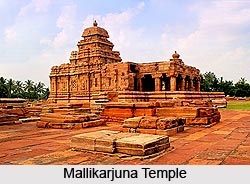 Bhutanatha group of temples is a cluster of sandstone shrines dedicated to the Lord Bhutanatha. The temples are nestled in Badami town in the Karnataka state of India. They are located near the famous Badami cave temples.
Bhutanatha group of temples is a cluster of sandstone shrines dedicated to the Lord Bhutanatha. The temples are nestled in Badami town in the Karnataka state of India. They are located near the famous Badami cave temples.
Architecture of Bhutanatha Group of Temples
This group of temples has two major temples, one on the east and the other on the north-east side of the Agasthya Tirtha or Agasthya Lake. The temple located on the east side of the lake is called the Bhutanatha temple. The superstructure of Bhutanatha temple resembles early South Indian style or North Indian style with its open hall or Veranda. The temple located on the north-east side of the lake is sometimes called Mallikarjuna group of temples. It features a stepped superstructure, commonly observed in Kalyani Chalukya constructions.
Bhutanatha Temple - The Bhutanatha temple presents architecture of different periods. The inner shrine and hall of the temple were built during the reign of the Badami Chalukyas in late 7th century. The outer mantapa which faces the Badami tank was constructed in 11th century during the rule of the Kalyani Chalukyas. The inner hall has massive pillars and the bays in the ceiling of the nave are decorated with lotus rosette. On one side of the doorway of the shrine stands Goddess Ganga, riding the vehicle makara,
 while on the other side is goddess Yamuna riding the tortoise. It is believed that the Shiva linga in the shrine was added later after the original deity in the sanctum was removed.
while on the other side is goddess Yamuna riding the tortoise. It is believed that the Shiva linga in the shrine was added later after the original deity in the sanctum was removed.
The temple is yet to be finished and at the base of the superstructure is vestiges of Jain architecture. The wall of the shrine and the hall exhibit decorative elements like makharas (mythical beast). There is a shrine to the north of the hall which was originally consecrated for Vishnu. The temple was eventually taken over by the followers of Lingayatism. They built an outer hall and installed a Nandi (vehicle of Shiva), and a Shiva linga inside the sanctum.
Mallikarjuna Temple - The Mallikarjuna temple belongs to the period of the later Chalukyas, the Chalukyas of Kalyani. It presents topological features which were popularized by the Kalyani Chalukya architects.
It has the tiered pyramid structure characteristic of Western Chalukya Architecture. Plain walls and angled eaves over the open hall are the features of Western Chalukya Architecture. The temples also feature pyramid shaped superstructures made of closely spaced horizontal tiers.





















